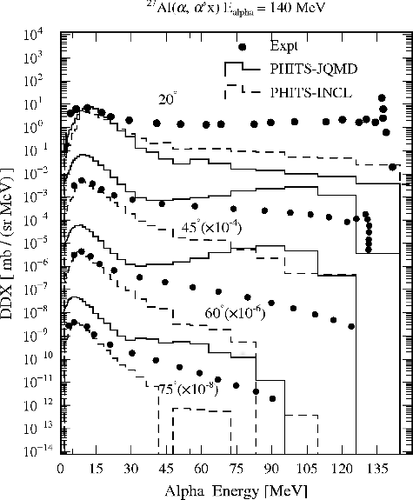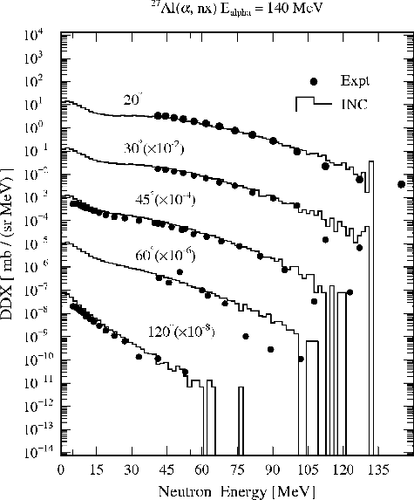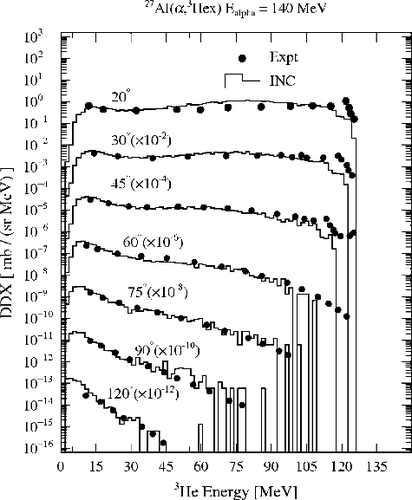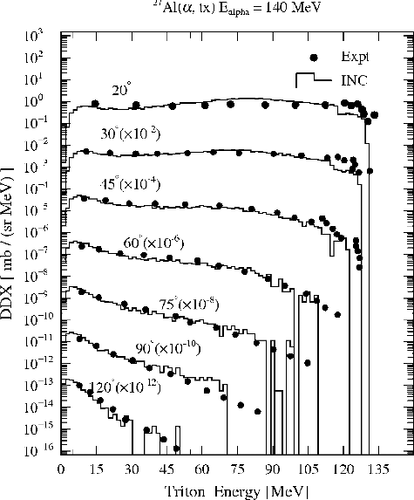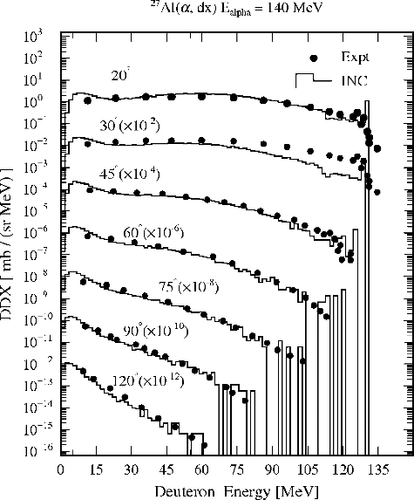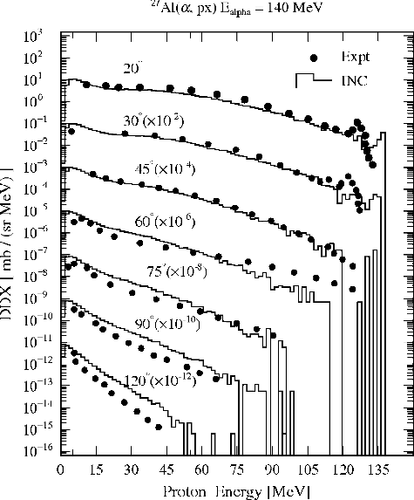 ?Mathematical formulae have been encoded as MathML and are displayed in this HTML version using MathJax in order to improve their display. Uncheck the box to turn MathJax off. This feature requires Javascript. Click on a formula to zoom.
?Mathematical formulae have been encoded as MathML and are displayed in this HTML version using MathJax in order to improve their display. Uncheck the box to turn MathJax off. This feature requires Javascript. Click on a formula to zoom.ABSTRACT
The intranuclear cascade model is extended to cluster-induced (deuteron and alpha particle) nuclear reactions involving inelastic scattering and breakup reactions. The proposed model explains the projectile breakup process by describing the projectile cluster as a superposition of several states. The incident cluster and the produced cluster are assumed to be collections of independent particles and may undergo nuclear interaction through nucleon–nucleon interaction with the target nucleus. Trajectory deflections for the projectile and ejecta are incorporated in the model to account for angular distributions. Calculations with the proposed model followed by the generalized evaporation model are performed for validation by comparing with experimental double-differential cross-section spectra produced by bombarding an 27Al target separately with 80-MeV and 99.6-MeV deuterons and 140-MeV alpha particles. The calculation results show good agreement with experimental spectra.
1. Introduction
Particle transport codes are widely used in a variety of applications to simulate radiation shielding, isotope burnup, material activation, and radiation dose. The physical processes considered for hadron transport include electromagnetic processes and hadronic processes, the latter of which are simulated using nuclear reaction models. Nowadays, nuclear reactions are modeled in two stages: the fast cascade process followed by the static process. The intranuclear cascade (INC) model, the quantum molecular dynamics (QMD) model, and other models are used to describe the cascade stage that emits fast particles. After the cascade stage, the residual nucleus de-excites via evaporation or fission, for which an evaporation–fission model is used. To describe the fast process, we have developed an INC code [Citation1] that has been incorporated into the widely used Monte Carlo Particle and Heavy Ion Transport code System (PHITS) [Citation2].
Fast-stage reactions have a variety of final channels. Hence, there is strong demand to improve the predictive accuracy of INC models and to expand their application to a variety of nuclear reactions involving many species of incident and emitted particles with a wide energy range. A highly predictive INC model has been realized for nucleon-induced nucleon emission, that is, (N, N’x) reactions [Citation3–6]. Some studies have considered heavy-ion reactions, but were limited to proton or pion production reactions [Citation7–9]. More recently, there has been some study of reactions induced by light clusters [Citation10,Citation11], but with little attention paid to the production of the clusters themselves.
All the final channels of cluster disintegration have similar strengths, so it is important to describe all channels equally (while noting that pickup-like reactions are negligibly weak). However, the predicted spectra of inelastic cluster scattering such as (d, d'x) and (α, α'x) reactions are poor. This is because both INC and QMD models treat nucleons as classical particles, and hence the composite nature of clusters (which is essential in cluster scattering calculations) is not treated. Typical examples are shown in and for the 80-MeV (d, d'x) and 140-MeV (α, α'x) reactions, respectively. In those figures, dashed and solid lines represent results calculated by INCL [Citation11] and JQMD [Citation12], respectively.
Figure 1. INCL (dashed lines) and JQMD (solid lines) model calculations for deuteron bombardment of an 27Al target at 80 MeV in comparison with experimental values (dots) taken from [Citation18 ]. For visualization purposes, each data-set has been multiplied by the factor shown in brackets.
![Figure 1. INCL (dashed lines) and JQMD (solid lines) model calculations for deuteron bombardment of an 27Al target at 80 MeV in comparison with experimental values (dots) taken from [Citation18 ]. For visualization purposes, each data-set has been multiplied by the factor shown in brackets.](/cms/asset/a96308c3-62d3-4423-80ad-e8e01e09b967/tnst_a_1389313_f0001_b.gif)
In previous work, we expanded our INC model to include reactions for proton-production and proton-induced cluster production at bombardment energies of 200 MeV or higher [Citation6,Citation13]. The model was subsequently extended to lower beam energies (∼50 MeV) by including collective excitations, trajectory deflections, and barrier transmission coefficients [Citation14]. However, such improvements apply to (p, p'x) reactions only. Moreover, the double-differential cross-section (DDX) spectra of 100-Me V 27Al(d, d'x) reactions have been explained successfully by introducing wave-function superposition into the INC model of the deuteron ground state [Citation13]. In the present study, we develop this approach to explain (d, px) reactions, and we expand the model to include alpha-induced reactions, namely (α, α'x), (α, 3Hex), (α, tx), (α, dx), (α, px), and (α, nx). We validate the model by using experimental data for an 27Al target. The dependences on incident energy and target mass are investigated in the future.
This paper is organized as follows. In Section 2, we describe the INC model used in this study, as well as how we improve it to include cluster-induced reactions. In Section 3, the present model is validated by comparing calculation results with experimental data. Finally, our conclusions are presented in Section 4.
2. Theoretical model
2.1. INC model for nucleon incidence
Our INC model for nucleon incidence sits within the framework of a two-stage model that consists of the INC for the fast-stage and the generalized evaporation model (GEM) [Citation15] for the static stage. The present calculation procedure is based on our previous model, which make good predictions for nucleon-induced reactions [Citation14,Citation16].
We describe briefly here our INC model of nucleon incidence reactions. The target nucleus is treated as a sphere with distributed nucleon density and momentum. The nucleon density follows a Woods–Saxon-type distribution [Citation17], whereas the momentum follows the degenerate Fermi distribution in the nuclear potential of 45 MeV. Because any nucleon below the Fermi sea is treated as unevolved, these parameters are those associated with an NN collision. The maximum nuclear radius is defined as Rmax = r0 + 5a0with a0 = 0.54fm and , where A is the atomic mass number. The maximum impact parameter for nucleon incidence is taken as Rmax. The energetic nucleons travel in straight lines inside the nucleus. If two nucleons approach each other within a distance
, they can undergo NN collision, the occurrence of which judged according to Pauli blocking. When a nucleon hits the target nuclear surface, it either escapes or is reflected depending on the transmission coefficient. Neutrons do not experience a Coulomb barrier, and the transmission coefficient for proton emission with the modified Gamow transmission factor is
(1)
(1) with
(2)
(2)
Here, λr and λc are parameters that depend on the target nucleus. Furthermore, ϵ is the emission energy, Vcoul is the Coulomb barrier, and Rmax satisfies the range , with classical turning point outside the potential, R′ct = λrRmax . We assume the reflected particle does not escape during cascade stage. The incident particle and the emitted particle are both deflected at the nuclear surface because of the nuclear potential.
2.2. Extension of INC model
Our model of cluster-induced reactions was developed on the basis of the nucleon reaction model described above. The essential improvement is the inclusion of the breakup of the incident cluster, which is assumed to occur at the initial-state interaction. To begin with, the ground state of the cluster is determined in the same way as for the target nucleus, which is described in Section 2.1. Since the potential depths of Vd for deuteron and Vα for α are sensitive to spectral shapes of emitted protons, we choose their values to fit the experimental data as described below. It is assumed additionally that the initial cluster wave function is given by superposing different states that consist of cluster units. For the alpha particle, the wave function is
(3)
(3) and for the deuteron it is
(4)
(4) with the normalization of
due to orthogonality. The probabilities calculated by these wave functions are used for INC event-by-event calculations. The inclusion of the cluster units allows us to treat their composite nature. The first term on the right-hand side of EquationEquation (3)
(3)
(3) indicates that the incident alpha particle is in a state in which it never disintegrates by interacting with the target nucleus. The second term represents the incident alpha particle breaking up into 3He + 1n as it enters the target nucleus. The resultant 3He particle undergoes no further disintegration in the subsequent reaction process. The momentum
of the 3He fragment is taken to be
(5)
(5) where
is the momentum of the ith nucleon of 3He, and
is the momentum of the alpha-particle projectile. The 3He transport is calculated under assumptions: the three constituent nucleons move in parallel with each other at a speed of the 3He cluster. One of the nucleons may collide with a target nucleon and accordingly receives momentum change, which is treated as the momentum change of the 3He cluster. The third to fifth terms of EquationEquation (3)
(3)
(3) represent the breakup of incident alpha into t + p, d + d, n + n + p + p, respectively, and the disintegration process is the same as that of the second term. Since relative yields of particles emitted from the reactions depend on the coefficients c in EquationEquations (3)
(3)
(3) and (Equation4
(4)
(4) ), the values of the coefficients were determined to fit the experimental data as listed in .
Table 1. Values of c coefficients in EquationEquations (3)(3)
(3) and (Equation4
(4)
(4) )
The impact parameter of the incident cluster is assigned randomly in the range 0–bmax. Here, bmax is the sum of the average radii of the projectile and the target rather than the sum of their cutoff radii (as is the case for nucleon incidence reactions) to fit with the experimental data.
In our INC model, the influence of the nuclear potential causes the incident particle and the outgoing particle to be deflected, which is known as trajectory deflection. For (p, p'x) calculations [Citation14,Citation16], the angular distribution of proton elastic scatterings was used to obtain a comprehensive description of the trajectory deflection. For cluster-induced reactions, trajectory deflection has a strong effect on the angular distributions of the fragments. Therefore, we determine new parameters for the trajectory-deflection angular distribution of each incoming and outgoing cluster. We have shown previously the probability Wdef,p of protons being deflected at angle in laboratory system, θ [Citation16]. For each cluster, the parameters were chosen to reproduce the spectral shapes of experimental DDX data for cluster emission reactions on the 27Al target:
(6)
(6)
(7)
(7)
(8)
(8)
(9)
(9) by using the Vd and Vα values determined for proton spectra.
The outgoing particle either travels through or is reflected at the nuclear surface, depending on the transmission coefficient. For clusters, we choose a step function
(10)
(10)
Compensation for nuclear recoil and the Q value is applied once the cascade process has finished.
The values of Vd and Vα were determined to reproduce spectral shapes of 27Al (d, px) and 27Al (α, px) reactions, respectively. shows comparison between the results for deuteron potential depths of 10, 15, and 20 MeV (represented by dotted, solid, and dashed lines, respectively) for the 27Al(d, px) reaction at 80 MeV; of these, we choose 15 MeV. We determined the alpha potential depth in the same way by using DDXs of the 27Al(α, px) reaction at 140 MeV. In , the results for depths of 30, 40, and 60 MeV are presented as the dash-dotted, solid, and dotted lines, respectively; of these, we chose 40 MeV.
Figure 3. Comparison of the calculation results for proton-production DDXs from 80-MeV deuterons bombarding 27Al at angles of 30°, 45°, and 60° for different values of the deuteron potential depth. The solid circles show the experimental data taken from EXFOR [Citation20]. The dotted, dashed, and line histograms are the INC calculation results for d potential depths of 10, 20, and 15 MeV, respectively. For visualization, the DDXs have been multiplied by the factors indicated.
![Figure 3. Comparison of the calculation results for proton-production DDXs from 80-MeV deuterons bombarding 27Al at angles of 30°, 45°, and 60° for different values of the deuteron potential depth. The solid circles show the experimental data taken from EXFOR [Citation20]. The dotted, dashed, and line histograms are the INC calculation results for d potential depths of 10, 20, and 15 MeV, respectively. For visualization, the DDXs have been multiplied by the factors indicated.](/cms/asset/5ba3530c-218b-4aee-bab1-7be7887f5178/tnst_a_1389313_f0003_b.gif)
Figure 4. Comparison of the calculation results for proton-production DDXs from 140-MeV alpha particles bombarding 27Al at angles of 20°, 30°, and 45° for different values of the potential depth for the incident alpha particle. The solid circles show the experimental data taken from EXFOR [Citation20]. The dash-dotted, solid, and dotted line histograms are the INC calculation results for alpha-particle potential depths of 30, 40, and 60 MeV, respectively. For visualization, the DDXs have been multiplied by the factors indicated.
![Figure 4. Comparison of the calculation results for proton-production DDXs from 140-MeV alpha particles bombarding 27Al at angles of 20°, 30°, and 45° for different values of the potential depth for the incident alpha particle. The solid circles show the experimental data taken from EXFOR [Citation20]. The dash-dotted, solid, and dotted line histograms are the INC calculation results for alpha-particle potential depths of 30, 40, and 60 MeV, respectively. For visualization, the DDXs have been multiplied by the factors indicated.](/cms/asset/5c286cb8-9ae5-41a8-bc37-5b9f4acf69e8/tnst_a_1389313_f0004_b.gif)
3. Calculation results and discussion
3.1. Deuteron-induced reactions
We tested the validity of our model through comparison with experimental observations for the bombardment of 27Al with deuterons of incident energy 80 or 99.6 MeV. The measured production spectra of deuterons and protons can be compared with the calculation results of our present model in –. Closed circles represent the experimental DDXs and solid-line histograms represent the calculation results. To avoid overlap, some factors indicated in the figures have been multiplied. The contribution of the GEM has been included in each calculation result. In these comparisons, we use the data of Wu et al. [Citation18] and Ridikas et al. [Citation19], and experimental data from EXFOR [Citation20].
Figure 5. INC model calculations coupled with GEM for 27Al(d, d'x) reaction at 80 MeV at angles of 30°–150°. The solid circles show the experimental data taken from EXFOR [Citation20] and the dots are the experimental data taken from [Citation18 ]. For visualization, the DDXs have been multiplied by the factors indicated.
![Figure 5. INC model calculations coupled with GEM for 27Al(d, d'x) reaction at 80 MeV at angles of 30°–150°. The solid circles show the experimental data taken from EXFOR [Citation20] and the dots are the experimental data taken from [Citation18 ]. For visualization, the DDXs have been multiplied by the factors indicated.](/cms/asset/0e3c6862-8f58-4f8b-bcf6-354fb957fbd4/tnst_a_1389313_f0005_b.gif)
Figure 6. Same as , but for 27Al(d, px) reaction at 80 MeV. The solid circles are the experimental data taken from EXFOR [Citation20].
![Figure 6. Same as Figure 5, but for 27Al(d, px) reaction at 80 MeV. The solid circles are the experimental data taken from EXFOR [Citation20].](/cms/asset/969d0e95-5fa3-4417-869f-3bc974bc5744/tnst_a_1389313_f0006_b.gif)
Figure 7. Same as , but for 27Al(d, px) reaction at 99.6 MeV. The solid circles are the experimental data taken from EXFOR [Citation20].
![Figure 7. Same as Figure 5, but for 27Al(d, px) reaction at 99.6 MeV. The solid circles are the experimental data taken from EXFOR [Citation20].](/cms/asset/6be21316-8607-4901-8e15-8bfd9385cf25/tnst_a_1389313_f0007_b.gif)
allows comparison between experimental DDXs and INC calculation results for 27Al(d, d'x) reactions at 80 MeV for angles of 30°–150°. Besides the experimental data from EXFOR (solid circles), we include numerical values from Wu et al. (dots). The EXFOR database is missing some data around the elastic scattering region, but overall the proposed model accounts successfully for the gross features of the deuteron spectra over the entire energy range.
The proton spectra observed from bombarding 27Al with deuterons at incident energies of 80 and 99.6 MeV are shown in and , respectively. In both cases, our INC model succeeds at reproducing the prominent broad peaks at the forwardmost angles at about half the incident energy that are due to breakup of the incident deuterons [Citation18]. Slight inconsistencies can be seen in the high-energy range of each spectrum, where the stripping reaction is dominant. The model calculations show a sharp peak at the highest energy at forward angles, which corresponds to 27Al(d, p)28Al reactions with a positive Q value. In , there are discrepancies in discrete-peak regions because of stripping reactions at excitations up to roughly 10 MeV for the 99.6-MeV case. Thanks mainly to the GEM, the low-energy regions (i.e. those that are governed by the evaporation process) are reproduced well. The tendency to underestimate that is observed in the results for spectra at angles of 90° or more is a common shortcoming of INC models.
3.2. Alpha-particle-induced reactions
We tested the present INC model for all available channels of the alpha-induced reactions of 27Al at 140 MeV, namely (α, α'x), (α, 3Hex), (α, tx), (α, dx), (α, px), and (α, nx). allow comparisons between the calculated DDX spectra (solid lines) and the experimental data (closed circles); for visualization purposes, the DDXs have been multiplied by the factors shown. In these comparisons, we have used the data of Wu et al. [Citation21] and experimental data taken from EXFOR [Citation20].
shows the case for (α, α'x) at laboratory angles of 20°–120°. The experimental data were taken from EXFOR [Citation20]. The highest energy peak of the alpha spectra, which corresponds to elastic scattering, is captured well by our calculations. The calculated alpha-production DDX spectra account well for the experimental results at all angles and over the entire energy range.
allows a comparison between experimental and calculated DDXs of neutrons at 20°, 30°, 45°, 60°, and 120° resulting from bombarding 27Al with 140-MeV alpha particles [Citation20]. The present model reproduces the features of the neutron spectra successfully. The discrepancy observed at 60° can be attributed to experimental uncertainty.
and show energy spectra for (α, 3Hex) and (α, tx) reactions, respectively, with 27Al at 140 MeV for laboratory angles of 20°–120°. The gross features of the 3He energy spectra are reproduced well by the present INC model, except in the high-energy region where the 27Al(α, 3He)28Al reaction is dominant. The overall features of the triton spectra from 27Al are reproduced well by our INC model, except at the high-energy end as in the case of 3He production. The one-neutron stripping-reaction mechanism is not considered in the present study. We believe the inclusion of the stripping-reaction mechanism could improve the accuracy of the model as we added the collective excitation process [Citation14,Citation16] for (p, p’x) reactions.
Deuteron spectra from 27Al for alpha particles at 140 MeV are shown in for laboratory angles of 20°–120°. The INC model accounts well for the forward-angle broad peaks at half the incident energy, which have been ascribed to the breakup of alpha particles [Citation22]. Good agreement with the experimental data is observed over the entire range of the deuteron spectra. The only exception is observed at the high-energy region of 30°.
shows comparison between the experimental and calculated proton energy spectra from 140-MeV alpha particles with 27Al. The present model accounts well for the gross features of the proton spectra. However, at small angles, a difference is observed in the high-energy region that is governed by the stripping reaction, and the present model results in overestimation at large angles (i.e. 90° and 120°).
4. Conclusion
We investigated our previously developed INC model to widen its applicable range to include deuteron- and alpha-induced reactions. We introduced the superposition of ground-state wave functions to explain a variety of final channels. Because the angular distributions are sensitive to the deflection of fragments, we incorporated trajectory deflection for both the cluster projectile and the ejecta. Considering the incident cluster as a collection of independent nucleons, we performed calculations within the framework of our INC model together with a GEM. The calculation results indicated that the proposed model has high predictive power for (d, d'x), (d, px), and all channels of alpha-induced reactions. The proposed model underestimated the high-energy end of spectra, which are occupied by transitions to discrete levels. We believe that the inclusion of the stripping reaction mechanism improves the model accuracy.
Acknowledgement
This work is supported partly by JSPS KAKENHI Grant Numbers 17H03522.
Disclosure statement
No potential conflict of interest was reported by the authors.
References
- Sawada Y, Uozumi Y, Nogamine S, et al. Intranuclear cascade with emission of light fragment code implemented in the transport code system PHITS. Nucl Instr Meth B. 2012;291:38–44.
- Sato T, Niita K, Matsuda N, et al. Particle and heavy ion transport code system, PHITS, version 2.52. J Nucl Sci Technol. 2013;50:913–923.
- Boudard A, Cugnon J, Leray S, et al. Intranuclear cascade model for a comprehensive description of spallation reaction data. Phys Rev C. 2002;66:044615.
- Duarte H. Particle production in nucleon induced reactions above 14 MeV with an intranuclear cascade model. Phys Rev C. 2007;75:024611.
- Budzanowski A, Fidelus M, Filges D, et al. Variation of nonequilibrium processes in the p+Ni system with beam energy. Phys Rev C. 2009;80:054604.
- Iwamoto H, Imamura M, Koba Y, et al. Proton-production double-differential cross sections for 300-MeV and 392-MeV proton-induced reactions. Phys Rev C. 2010;82:034604.
- Yariv Y, Fraenkel Z. Intranuclear cascade calculation of high-energy heavy-ion interactions. Phys Rev C. 1979;20:2227.
- Cugnon J. Monte Carlo calculation of high-energy heavy-ion interactions. Phys Rev C. 1980;22:1885.
- Yariv Y, Fraenke1 Z. Intranuclear cascade calculation of high energy heavy ion collisions: effect of interactions between cascade particles. Phys Rev C. 1981;24:488.
- Mathews GJ, Glagola BG, Moyle RA, et al. Inclusion of deuteron and alpha-particle collisions in intranuclear cascade calculations. Phys Rev C. 1982;25(5):2181.
- Boudard A, Cugnon J, David JC, et al. New potentials of the Liege intranuclear cascade model for reactions induced by nucleons and light charged particles. Phys Rev C. 2013;87(1):014606.
- Niita K, Chiba S, Maruyama T, et al. Analysis of the ( N,xN ’) reactions by quantum molecular dynamics plus statistical decay model. Phys Rev C. 1995;52:2620.
- Uozumi Y, Sawada Y, Mzhavia A, et al. Deuteron-production double-differential cross sections for 300- and 392-MeV proton-induced reactions deduced from experiment and model calculation. Phys Rev C. 2011;84:064617.
- Uozumi Y, Yamada T, Nakano M. Intranuclear cascade model for 50-MeV-region (p, p′x) reactions over a wide target mass range. J Nucl Sci Technol. 2015;52:264–273.
- Furihata S. Statistical analysis of light fragment production from medium energy proton-induced reactions. Nucl Inst Meth B. 2000;171:251–258.
- Uozumi Y, Yamada T, Nogamine S, et al. Intranuclear cascade model including collective excitations and trajectory deflections for (p,p'x) reactions around 50 MeV. Phys Rev C. 2012;86:034610.
- Negele JW. Structure of finite nuclei in the local-density approximation. Phys Rev C. 1970;1:1260–1321.
- Wu JR, Chang CC, Holmgren HD. Charged-particle spectra: 80 MeV deuterons on 27Al and 58NI and 70 MeV deuterons on 90Zr, 208 Pb and 232Th. Phys Rev C. 1979;19:370–390.
- Ridikas D, Mittig W, Savajols H, et al. Inclusive proton production cross sections in (d,xp) reactions induced by 100 MeV deuterons. Phys Rev C. 2000;63:146101.
- EXFOR/CSISRS experimental nuclear reaction data. Available from: http://www.nndc.bnl.gov/exfor/ exfor00.htm.
- Wu JR, Chang CC, Holmgren HD. Charged particle spectra: 140 MeV α particle bombardment of 27Al, 58Ni, 90Zr, 209Bi, and 232Th. Phys Rev C. 1979;19:659–673.
- Wu JR, Chang CC, Holmgren HD, et al. Alpha-particle breakup at incident energies of 20 and 40 MeV/nucleon. Phys Rev C. 1979;20(4):1284.

